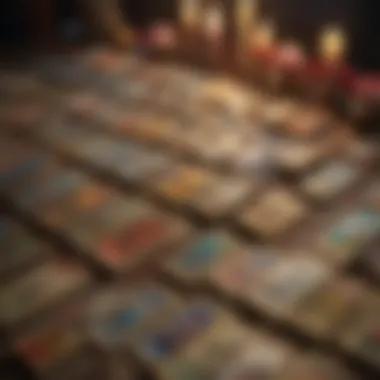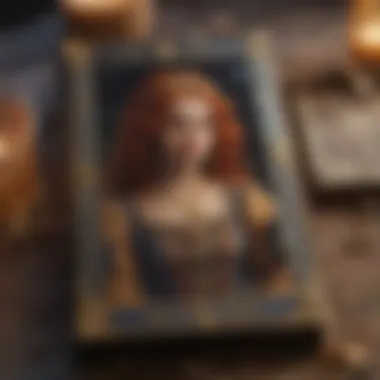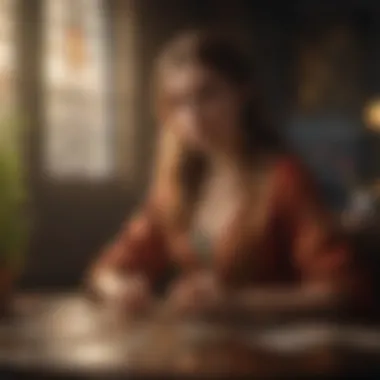Decoding Tarot Messages: Understanding Intention and Feelings


Intro
In the realm of human connections, understanding one another's intent can be challenging. Tarot cards serve as a unique tool that bridges this gap. They offer insights not only into individual feelings but also into relationship dynamics. By analyzing tarot readings, one can begin to decode messages that reveal underlying emotions and thoughts. This exploration leads to a deeper comprehension of interpersonal communication.
As we navigate this topic, this article will focus on how tarot helps in interpreting what someone wishes to convey, especially in romantic contexts. Understanding the cards is not just about their surface meanings. It requires examining the implications of each card, the surrounding cards, and the context of the question asked.
Moreover, the relationship between astrology and tarot cannot be overlooked. Each zodiac sign has specific traits that may influence how individuals express their feelings. To delve into this subject, we will first explore Zodiac Profiles, an essential aspect that enhances our grasp on interpersonal dynamics through tarot.
Zodiac Profiles
Overview of Each Sign
Each zodiac sign embodies distinct characteristics that shape how individuals interact and express their emotions. In tarot readings, these traits often play a pivotal role in interpretation. Here is a summary of each sign:
- Aries: Bold, energetic, impulsive.
- Taurus: Patient, reliable, stubborn.
- Gemini: Curious, social, inconsistent.
- Cancer: Nurturing, sensitive, moody.
- Leo: Confident, creative, arrogant.
- Virgo: Analytical, meticulous, critical.
- Libra: Diplomatic, charming, indecisive.
- Scorpio: Intense, passionate, secretive.
- Sagittarius: Adventurous, optimistic, blunt.
- Capricorn: Ambitious, disciplined, pessimistic.
- Aquarius: Innovative, independent, aloof.
- Pisces: Compassionate, intuitive, escapist.
Personality Traits
Understanding personality traits associated with each sign can enhance the interpretation of tarot messages. For instance, a Scorpio may be more likely to exhibit passionate feelings through the The Lovers card. In contrast, a Libra might be reflected in the balance depicted in Justice. Knowing these traits can guide readers when interpreting the emotional landscape during a reading.
Strengths and Weaknesses
When interpreting the tarot, it is also important to consider each sign's strengths and weaknesses:
- Strengths may reveal positive intentions. For example, the nurturing aspect of Cancer might indicate a desire for closeness.
- Weaknesses can uncover fears or insecurities. A Taurus may struggle with possessiveness, which can be highlighted in cards like The Devil.
Understanding these aspects creates a foundation when combining tarot insights with astrological analysis, enriching the overall comprehension of interpersonal communication.
Compatibility Insights
Love and Relationships
Tarot not only reveals individual emotions but offers insights into compatibility within relationships. By drawing cards focused on love, one can gauge mutual feelings and potential obstacles. Key cards like Two of Cups and The Empress can signify a strong, harmonious bond, while Five of Wands may indicate conflicts or competition.
Friendship Compatibility
Friendship dynamics also reflect the underlying messages found in tarot readings. Some signs naturally bond well together, while others may face challenges. For example, a Virgo might appreciate the groundedness of a Capricorn, whereas a Gemini may find it difficult to connect deeply with a Scorpio.
Workplace Dynamics
In the professional realm, tarot readings can guide insights into workplace dynamics. Relationships among colleagues can often be enhanced by understanding individual traits. For example, drawing cards related to teamwork, such as Three of Pentacles, may highlight the importance of collaboration.
Astrological Events
Monthly/Weekly Horoscope Breakdown
Astrological events, such as retrogrades and new moons, can influence tarot readings and interpersonal chemistry. Keeping track of these phases may provide better clarity during consultations.
Notable Celestial Events
Eclipses and planetary transits can shed light on significant changes within relationships. Understanding these events may increase the efficacy of tarot insights.
How to Prepare for Astrological Shifts
Preparation is key. Keeping a journal to track emotions and significant events during these periods may enhance the effectiveness of tarot readings. Reflect on how shifts influence personal and interpersonal dynamics to gain deeper insights from the cards.
Preamble to Tarot and Relationship Insights
Understanding tarot is essential for those seeking deeper insights into their relationships. Tarot cards act as a medium through which one can access subconscious thoughts and feelings. This is especially relevant when trying to decode messages from a partner. By interpreting these cards correctly, individuals can unveil layers of meaning that are often not articulated in verbal communication.
What is Tarot?


Tarot is a deck of cards with origins tracing back to the 15th century in Europe. Originally meant for entertainment, it has evolved into a meaningful tool for divination and self-reflection. Each card holds unique symbolism and meaning, which can vary depending on context. The deck consists of 78 cards, divided into Major and Minor Arcana. The Major Arcana represents significant life events, while the Minor Arcana covers day-to-day experiences. This duality allows tarot to provide both broad and specific insights into one's life and relationships.
The Role of Tarot in Relationships
In the realm of relationships, tarot serves many purposes. It can provide clarity in confusing situations, reveal hidden intentions, and even affirm feelings. Many individuals utilize tarot to navigate the complexities of romantic entanglements. When interpreting tarot in this context, it’s crucial to focus on the specific cards drawn and their placements.
- Gaining insight: Tarot can highlight aspects of a relationship that may not be immediately apparent.
- Encouraging communication: The findings from a reading often prompt discussions that might not happen otherwise.
- Promoting self-awareness: Understanding one's reactions and desires can lead to healthier relationship dynamics.
Tarot is not about predicting fate; it is about understanding the present and making informed decisions for the future.
Through examining both the individual cards and their combinations, tarot readings can inform personal growth and relationship development. This prepares a person to approach their circumstances with more clarity and intention.
Understanding Tarot Card Meanings
Understanding the meanings of tarot cards is crucial to deciphering the messages they convey, especially in the context of interpersonal relationships. Each card possesses its unique symbolism and contributes to a broader narrative. Thus, this section aims to illuminate the layers built into tarot card meanings that can shed light on what he truly wants to communicate.
When you draw a card, its implications are multifaceted. For example, specific cards may indicate feelings of love, while others might suggest hesitation or fear. Recognizing these nuances allows you to extract actionable insights from readings. Moreover, understanding these meanings fosters deeper self-awareness and aids in communication with others, helping to navigate emotional landscapes more effectively.
Major Arcana: Major Life Themes
The Major Arcana cards consist of 22 cards that represent significant life events, spiritual lessons, and deep emotional issues. Each card, such as The Fool, The Lovers, and Death, carries major themes that resonate with life's journey. For example, The Lovers signifies choices in love and partnership, whereas The Tower signifies sudden upheaval and change.
When interpreting these cards in the context of relationships, it is essential to analyze what aspects of one’s life or emotions are highlighted. Major Arcana cards reflect pivotal experiences that can characterize the relationship dynamics at play, offering deeper insights into his feelings and intentions.
Minor Arcana: Everyday Influences
The Minor Arcana cards provide context to the daily situations and challenges we face. They are divided into four suits: Cups, Pentacles, Swords, and Wands. Each suit pertains to different aspects of life, such as emotional matters, material concerns, communication, and action.
For example, if you draw a card from the Cups suit, it may suggest emotional connections or feelings. The Knight of Cups, a card representing romance and charm, might indicate that he has romantic feelings but may not express them openly. Recognizing the everyday circumstances reflected in these cards enhances your ability to read the subtle signs and influences affecting his behavior.
Court Cards: Interpersonal Dynamics
The Court Cards—Page, Knight, Queen, and King—represent personalities and interactions within relationships. These cards can personify the subject, reflecting his demeanor, thoughts, and emotional state. For instance, drawing the King of Cups may mean he is emotionally mature and capable of offering support, while the Page of Swords might represent a youthful, curious energy, signaling that he is working through his issues.
Understanding the Court Cards requires a keen insight into interpersonal dynamics. Each card reveals how he interacts not only with you but also with the world around him. By interpreting these characters, you can glean valuable information about his intentions and approach to relationships.
The power of Tarot lies not only in the cards themselves, but also in the narrative you weave from them.
By comprehensively understanding the implications of Major Arcana, Minor Arcana, and Court Cards, you gain the ability to make informed interpretations about what he might be trying to convey through the deck. This understanding paves the way for clearer communication and helps you navigate your emotional landscape with intention and clarity.
Interpreting His Intentions through Tarot
Understanding another person's intentions can be complicated, especially in relationships. Tarot offers a unique lens through which we can decode these intentions. Each card holds specific meanings that can provide clarity about feelings and desires. This section aims to explore how to interpret these cards effectively, emphasizing the importance of context and intuition in the reading process.
Cards Indicating Attraction
When interpreting tarot in the context of attraction, certain cards stand out. The Two of Cups often symbolizes mutual attraction and partnership. It depicts a balanced connection where both individuals share feelings.
Another significant card is the Lovers. This card suggests not just attraction, but a deeper emotional bond. It indicates that the feelings may stem from a genuine connection, indicating that he sees a future with you.
- Ace of Wands represents passion and enthusiasm. Its appearance can signify a spark in the relationship.
- Page of Cups embodies youthful affection and emotional openness. It can denote a budding interest or flirtation from him.
These cards must be interpreted in conjunction with their positions and surrounding cards to gain full insight.
Cards Suggesting Hesitation or Uncertainty
Not all cards convey confidence and assurance. Certain tarot cards can indicate hesitance in intentions. The Seven of Cups often highlights indecision. It represents a person who is overwhelmed by choices and may be unsure about their feelings. This could mean he is contemplating various aspects of the relationship before moving forward.
Another card to consider is the Hanged Man. This card symbolizes a period of reflection. It suggests that he may be pausing to reassess his feelings or the relationship itself.
- Two of Swords represents a stalemate. It suggests that he is struggling to make a decision in the emotional realm.
- Nine of Wands can indicate defensiveness. It shows that he may have faced challenges previously and is now guarded.
Understanding these cards in context allows for a better grasp of his emotional state.


Assessing Commitment and Long-term Intentions
Commitment is a vital aspect of relationships, and specific tarot cards can shed light on this area. The Ten of Pentacles often reflects stability and long-term planning. Its presence usually indicates a desire for a lasting connection, suggesting that he views you as part of a broader future.
The Four of Wands signifies celebration and groundwork for a solid relationship. This card often indicates he wishes to create a home or family environment with you, displaying commitment on his part.
- King of Pentacles embodies responsibility and security. His appearance can suggest that he is ready to invest in a long-term partnership.
- The Hierophant denotes traditions and long-standing values. It may signify his desire for a committed, conventional relationship.
Assessing these cards helps provide insight into whether he is truly committed or is still contemplating his long-term intentions.
Practical Steps to Analyze a Tarot Spread
Analyzing a tarot spread is integral to deciphering the complex messages it conveys. This process not only clarifies your inquiries about relationships but also deepens your understanding of the emotions and intentions at play. A well-thought-out tarot reading can illuminate aspects of a relationship that might not be immediately visible, offering a pathway to better communication and insight.
Choosing the Right Spread for Relationship Insights
Selecting an appropriate tarot spread is the first step to gaining meaningful relationship insights. Different spreads cater to varying questions and circumstances. Some may focus on past influences, while others offer a glimpse into future potentials. The popular Celtic Cross spread can provide a broader overview, whereas the three-card spread is quite efficient for more specific questions. For relationship reading, the following spreads may yield fruitful results:
- Romantic Relationship Spread: This spread explores the dynamics between partners.
- Needs and Desires Spread: This allows for insights into what each partner seeks from the relationship.
- Conflict Resolution Spread: This spread addresses issues currently affecting the relationship.
Before you begin, ensure to reflect on the question or concern that you have. The clarity of your inquiry directly influences the quality of the insights attained.
Position Meanings in Relation to He
In tarot readings, the position of each card in the spread holds significant meaning. Every placement corresponds to a different aspect of the relationship or the individual's thoughts and feelings. Understanding the meanings behind each position can unlock deeper insights. Here are a few common positions explained:
- Present Situation: Represents the current state of the relationship or his feelings.
- Challenges: Indicates obstacles he may be facing or contributing to any tension.
- Future Influence: Suggests upcoming events or changes that may influence the relationship.
When interpreting the cards in their specific positions, consider how they relate to the question you posed. The interaction between the card meanings and their positions will guide your understanding of his intentions and feelings.
Connecting the Dots Between Cards and Relationship Context
Once you have interpreted the individual card meanings and their positions, the next step is to draw connections between them and the overall relationship context. This is where a holistic approach to tarot reading comes into play.
- Analyze how different cards communicate with one another. Look for recurring themes or contrasting messages.
- Pay attention to the emotions evoked by the cards; they may resonate with your experiences.
- Assess the cards in light of your relationships' history and current dynamics.
This final synthesis enables you to formulate a comprehensive understanding of what he might be communicating through the tarot spread. Remember, intuition plays a crucial role here, merging learned meanings with personal insights.
Common Misinterpretations in Tarot Readings
Understanding common misinterpretations in tarot readings is critical for ensuring that the insights gained are accurate and relevant. Misunderstandings often arise from oversimplified interpretations or lack of contextual awareness. This section emphasizes how discerning these misinterpretations can greatly enhance the effectiveness of tarot as a tool for relationship insights.
Overgeneralizing Card Meanings
One of the most common pitfalls is overgeneralizing the meanings of tarot cards. Each card carries multiple layers of significance that can shift based on surrounding cards and personal circumstances. For example, while The Lovers card typically represents romantic relationships, its interpretation changes greatly when paired with cards such as The Tower, which signifies upheaval. Without understanding the nuances, one might conclude that a relationship is purely harmonious, thus missing critical indications of challenges that may be present.
Key Considerations:
- Card Position: The position of a card within a spread dictates its meaning, adding context that can alter the interpretation.
- Card Combination: Different cards appearing in succession can create new meanings that may contradict the general understanding of a single card.
- Intuition & Personal Experience: Each reader brings their unique understanding and intuition into a reading, which influences how a card is interpreted.
Ignoring Contextual Elements
Context is essential in tarot readings. Ignoring the specific context of a question or the current situation can lead to misleading interpretations. Tarot does not operate in a vacuum; it reflects upon the individual’s life circumstances.
Important Contextual Factors:
- Relationship Status: Knowing if the relationship is new, long-term, or struggling will help in interpreting the cards accurately.
- Question's Focus: A vague question leads to vague answers. Being explicit allows the cards to provide more relevant insights.
- External Influences: Elements such as life changes, emotional states, or environmental factors can affect both the reading and the querent’s mindset.
Quote: “Contextual awareness can be the difference between clarity and confusions in tarot readings.”
Emotional Bias in Interpretation


Emotions play a pivotal role in how one interprets tarot readings. Personal biases can cloud judgment, leading to a skewed understanding of the messages conveyed through the cards. When individuals approach readings with strong desires or fears, they may project these emotions onto the cards.
How to Manage Emotional Bias:
- Self-Reflection: Before a reading, take time to reflect on your feelings and intentions. This prepares the mind for a more objective interpretation.
- Seek Neutral Perspectives: Consider consulting with another tarot reader to gain a fresh perspective. External insights can balance an emotionally charged viewpoint.
- Document Reactions: Keeping a journal of past readings can reveal patterns of bias and help facilitate awareness in future interpretations.
By addressing these common misinterpretations, your tarot readings can become more meaningful and insightful. This clarity allows for a deeper comprehension of what he really wants to communicate through the cards.
Integrating Tarot Insights with Intuition
Integrating tarot insights with intuition is essential for people seeking deeper understanding in their relationships. When tarot cards are drawn, they provide a framework for interpreting situations, feelings, and potential outcomes. However, the analytical side of tarot should not overshadow the intuitive aspect. Tapping into one’s inner voice can uncover layers of meaning that may not be immediately apparent. As a result, the readings become more personalized and resonant.
This integration helps bridge the gap between what the cards symbolize and what the situation entails on a personal level. Understanding this synergy enhances the effectiveness of the readings, making them more relevant to unique circumstances.
Trusting Your Inner Voice
Trusting your inner voice involves listening to those subtle nudges or feelings you may experience during a tarot reading. Often, your gut reaction to a specific card can reveal insights about your emotional state and the underlying dynamics of your relationships. By connecting to these instinctive feelings, you can cultivate a more profound understanding of not only the tarot message but also your own emotions.
Some ways to strengthen trust in your intuition include:
- Practicing mindfulness: Regular meditation can help clear the mind and make it easier to hear your inner voice.
- Reflecting on past experiences: Consider situations where trusting your intuition led to positive outcomes.
- Engaging with the imagery: Spend time contemplating the artwork of tarot cards; sometimes, the visuals speak directly to your subconscious.
Trusting your inner voice is not just about understanding the cards but understanding yourself.
Balancing Rational Thought with Intuitive Understanding
Achieving a balance between rational thought and intuitive understanding is critical in tarot readings. Rational thinking allows you to analyze the meanings of each card; however, overly analytical views can lead to misinterpretations. On the other hand, if you rely solely on intuition, you risk ignoring the broader context and meanings.
To find this balance, consider the following strategies:
- Engage in dual interpretation: Look at the cards from both a logical and an intuitive perspective. Write down what each card suggests logically, and then capture your emotional response.
- Seek external resources: Read literature related to tarot interpretations to expand rational knowledge. This resource might include works from authors like Rachel Pollack or Mary K. Greer.
- Discuss readings with others: Sharing your insights with friends or community groups can provide alternative viewpoints that enrich your understanding.
Case Studies in Tarot readings
Understanding the practical applications of tarot can greatly enhance one's ability to interpret messages related to relationships. Case studies in tarot readings serve as valuable touchpoints for examining how the interpretations of individual cards translate into real-life scenarios. They provide concrete examples of how tarot cards can reflect actual feelings and intentions in relationships.
These case studies highlight both the common and unique ways in which tarot can assist in relational insight. By analyzing different situations, you can appreciate the multifaceted nature of tarot readings, which often go beyond generic meanings. Insights derived from real-life scenarios add layers of relatability and engagement to the art of tarot. Moreover, these serve to illustrate the subtlety required for effective communication in interpreting one’s feelings towards another.
Real-Life Scenarios and Their Tarot Interpretations
Examining real-life scenarios offers clarity on how tarot cards manifest feelings and intentions. For example, consider a situation where someone draws The Lovers card while questioning their partner's commitment. This card could indicate a deep emotional bond, but it might also point to choices that need to be made. If the context involves uncertainty or argument, The Lovers can signal a need for open communication about needs and desires.
Another situation involves someone pulling the Five of Cups. This card traditionally reflects loss and regret. If a client is inquiring about a partner who has distanced themselves, this card may suggest that the partner feels remorse for past actions. It encourages the querent to look beyond the emotional pain and focus on what can still be salvaged in the relationship.
Ultimately, each drawn card acts like a mirror, reflecting the complexities of the situation and prompting necessary discussions that may not have otherwise occurred.
Successful Outcomes from Clarity in Communication
Tarot readings can lead to successful outcomes when they foster clarity in communication. When individuals gain insight from their readings, they often find they are better equipped to articulate their thoughts and feelings. For instance, if someone identifies a recurring card in their readings, like The High Priestess, which denotes intuition and inner wisdom, they may realize the importance of trusting their gut in discussions with their partner.
Clear communication can lead to several positive outcomes, such as:
- Improved Conflict Resolution: Understanding the underlying emotions related to tarot can help to navigate disagreements more effectively.
- Enhanced Emotional Intimacy: Tarot can prompt individuals to share thoughts they might otherwise keep hidden.
- Strengthened Decision-Making: Having clarity on what card meanings convey allows for more informed choices in relationships.
Positive outcomes from a tarot reading don't always mean a happy ending. Instead, they often pave the way for deeper understanding, open dialogue, and growth within the relationship. By reassessing their emotions in light of tarot, individuals can gain transformative insights that lead to healthier relational dynamics.
Culmination: The Value of Tarot in Understanding Relationships
Understanding relationships can often feel challenging, even with clear communication. Tarot gives us a tool to navigate this complexity, serving as a bridge between our subconscious thoughts and our conscious decisions. Through tarot readings, individuals can gain a deeper understanding of not only their own feelings but also the emotions and intentions of others.
By interpreting tarot messages, we can discover insights that may not be immediately apparent in everyday interactions. This practice empowers individuals to make informed decisions. It reduces feelings of uncertainty, enabling one to approach relationships with clarity rather than confusion.
Empowering Decision-Making through Tarot
Tarot aids decision-making by shedding light on various possibilities. When one connects with the symbolism of the cards, personal dilemmas can be approached from various angles. For example, drawing a card like The Lovers may emphasize a choice regarding commitment. In contrast, The Tower could indicate a need for change, urging the individual to re-evaluate their current situation.
Consider the following benefits of utilizing tarot for decision-making:
- Clarity: Tarot can simplify complex emotions and choices, allowing for structured thought processes.
- Perspective: Reflecting on card meanings can introduce new viewpoints.
- Introspection: It encourages deeper self-reflection, igniting critical thinking about relationships.



